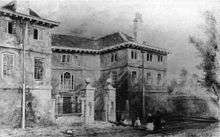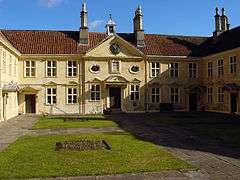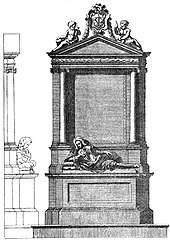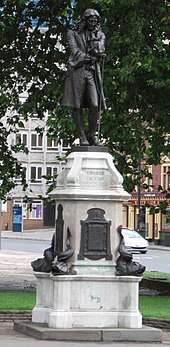Edward Colston
Edward Colston (2 November 1636 – 11 October 1721) was an English merchant, philanthropist and Tory Member of Parliament who was involved in the Atlantic slave trade.
Edward Colston | |
|---|---|
 Portrait by Jonathan Richardson | |
| Member of Parliament for Bristol | |
| In office 1710 – 1713 | |
| Personal details | |
| Born | 2 November 1636 Bristol, England |
| Died | 11 October 1721 (aged 84) Mortlake, Surrey, England |
| Political party | Tory |
| Occupation | Merchant |
Colston followed his father in the family business becoming a sea merchant, initially trading in wine, fruits and textiles, mainly in Spain, Portugal and other European ports. By 1680, he became involved in the slave trade as a member of the Royal African Company, which held a monopoly on the English trade in African slaves. He was deputy governor of the company in 1689–90.
Colston's name was widely commemorated in Bristol landmarks, and a statue of him was erected in 1895. With growing awareness in the late 20th century of his involvement in Britain's slave trade, there were protests and petitions for name changes, culminating in June 2020, when the statue was toppled and pushed into Bristol Harbour during protests in support of Black Lives Matter.
Early life
Colston was born on 2 November 1636 in Temple Street, Bristol, and baptised in the Temple Church, Bristol.[1] His parents were William Colston (1608–1681), a prosperous Royalist merchant who was High Sheriff of Bristol in 1643, and his wife Sarah Batten (d.1701), daughter of Edward Batten; he was the eldest of at least 11 and possibly as many as 15 children. The Colston family had lived in the city since the late 13th century.[2] Colston was brought up in Bristol until the time of the English Civil War, when he probably lived for a while on his father's estate in Winterbourne, just north of the city. The family then moved to London.[3]
Career
In 1654 Colston was apprenticed to the Mercers Company for eight years, and in 1673 he was enrolled into it.[3] By 1672 he had become a merchant in London.[2] Like his father Colston exported in textiles from London while importing oils, wine and sherry from Spain and Portugal. He also traded silk with Virginia and was a regular trader of Newfoundland cod to Naples.[1] He had built up a successful business trading with Spain, Portugal, Italy and Africa.[3]
In 1680, Colston became a member of the Royal African Company, which had held the monopoly in England on trading along the west coast of Africa in gold, silver, ivory and slaves from 1662.[3] Colston was deputy governor of the company from 1689 to 1690.[2] His association with the company ended in 1692.[2] This company had been set up by King Charles II and his brother the Duke of York (later King James II), who was the governor of the company, together with City of London merchants, and it had many notable investors, including philosopher and physician John Locke (who later changed his stance on the slave trade) and the diarist Samuel Pepys.[4][5]
During Colston's involvement with the Royal African Company from 1680 to 1692 it is estimated that the company transported over 84,000 African men, women and children to the Caribbean and the rest of the Americas, of whom as many as 19,000 may have died on the journey.[6] The slaves were sold for labour on tobacco, and, increasingly, sugar plantations, whose planters considered Africans would be more suited to the conditions than British workers, as the climate resembled the climate of their homeland in West Africa. Enslaved Africans were much less expensive to maintain than indentured servants or paid wage labourers from Britain.[7]
Colston's parents had resettled in Bristol. In 1682 he made a loan to the Bristol Corporation and the following year, became a member of the Society of Merchant Venturers.[8]
Although a Tory High Churchman and often in conflict with the Whig corporation of Bristol, Colston transferred a large segment of his original shareholding to William III at the beginning of 1689, securing the new regime's favour for the African Co. The value of Colston's shares increased and being without heirs he began to donate large sums to charities. He withdrew from the African Co. in 1692, but continued trading in slaves privately. He retired in 1708. Colston was MP for Bristol (1710-13).[9]
Death

Colston died on 11 October 1721, aged 84, at his home, (old) Cromwell House (demolished 1857), in Mortlake, south west London. His will stated that he wished to be buried simply without pomp, but this instruction was ignored.[10] His body was carried to Bristol and was buried at All Saints' Church. His monument was designed by James Gibbs with an effigy carved by John Michael Rysbrack.[11]
Colston never married, and settled a "considerable fortune in land" on his nephew Edward Colston (MP for Wells), when Edward married in 1704.[12]
Philanthropic works

Colston supported and endowed schools, houses for the poor, almshouses, hospitals and churches in Bristol, London and elsewhere and his name features widely on Bristol buildings and landmarks. However, it not known how much Colston gave to such charities.[6][13]
In Bristol, he founded almshouses in King Street and Colstons Almshouses on St Michael's Hill, endowed Queen Elizabeth's Hospital school, and helped found Colston's Hospital, a boarding school which opened in 1710 leaving an endowment to be managed by the Society of Merchant Venturers for its upkeep.[3] He gave money to schools in Temple (one of which went on to become St Mary Redcliffe and Temple School) and other parts of Bristol, and to several churches and the cathedral.[3]
David Hughson, writing in 1808, described Colston as "the great benefactor of the city of Bristol, who, in his lifetime, expended more than 70,000L. [£] in charitable institutions".[14]
Memorials

Buildings in Bristol named in memory of Colston include the Colston Tower and Colston Hall. Colston Avenue and Colston Street are also named after him, as is a regional bread bun, the Colston bun.[3][15] A statue of Colston is on the exterior of Bristol Guildhall, built 1843–46.[16] There is a 1870 stained-glass window by Clayton and Bell to his memory in the north transept of St Mary Redcliffe.[17] A window in Bristol Cathedral was dedicated to Colston's memory; the Cathedral announced in June 2020 that they will remove the window.[18]
City-centre memorial statue

In 1895, 174 years after Colston's death, a statue designed by John Cassidy was erected in the centre of Bristol, to commemorate Colston's philanthropy.[19] It stood for 125 years, until 7 June 2020, when the statue was toppled and pushed into Bristol Harbour by demonstrators during the George Floyd protests.[20][21] The statue was retrieved from the harbour four days later by Bristol City Council and taken to a secure location. It will later become a museum exhibit.[22]
In 2018, text for a new plaque for the statue was proposed intended to better inform the public about Colston's history.[23] Conservative councillor Richard Eddy and the Society of Merchant Venturers, which Colston had belonged to,[24] objected to the wording, and were successful in – among other things – removing mention of Colston's role as a Tory MP and the selective nature of his philanthropy, and disputed the number and ages of the children that died on his ships.[23] The new wording was vetoed by the Mayor of Bristol, Marvin Rees, who saw the Society as having had too much say in the process, instructing more parts of the community to be involved in producing the plaque.[23] After the statue was toppled, the Merchant Venturers said that it had been "inappropriate" for them to have become involved in the rewording of the plaque in 2018, and that the removal of the statue was "right for Bristol".[24]
Modern reappraisal
Since at least the 1990s, with increasing recognition of Colston's role in the slave trade, there has been growing criticism of his commemoration.[25] The Dolphin Society, which was formed to continue Colston's philanthropy, now refers to 'the evils of slavery' and recognises that 'black citizens in Bristol today can suffer disadvantage in terms of education, employment and housing for reasons that connect back to the days of the trans-Atlantic slave trade'.[13]
The proportion of Colston's wealth that came from his involvement in the slave trade and slave-produced sugar is unknown, and can only be the subject of conjecture. He also made money from trading in other commodities and interest from money lending.[1]
In April 2017, the charity that runs the Colston Hall, the Bristol Music Trust,[26] announced that it would drop the name of Colston when it reopened after refurbishment in 2020. There had been protests and petitions calling for a name change and some concertgoers and artists had boycotted the venue because of the Colston name.[27] Following the decision, petitions to retain the name of Colston reached almost 10,000 signatures, though the charity confirmed that the name change would go ahead.[28]
In November 2017, Colston's Girls' School, which is funded by the Society of Merchant Venturers, announced that it would not drop the name of Colston because it was of "no benefit" to the school to do so.[29] In summer 2018, after consultation with pupils and parents, Colston Primary School renamed itself Cotham Gardens Primary School.[30] In February 2019, St Mary Redcliffe and Temple School announced that it would rename its Colston 'school house', after the American mathematician Katherine Johnson.[31]
See also
References
- Morgan, Kenneth (1999). Edward Colston and Bristol (PDF). Bristol: Bristol Branch of the Historical Association. p. 3. Archived (PDF) from the original on 8 June 2020.
- Hanham, Andrew A. (April 2006). Hayton, David; Cruickshanks, Eveline; Handley, Stuart (eds.). "Colston, Edward II (1636-1721), of Mortlake, Surr". The History of Parliament. Cambridge University Press / Institute of Historical Research. Retrieved 13 June 2020.
- Morgan, Kenneth (September 2004). "Colston, Edward". Oxford Dictionary of National Biography (online ed.). Oxford University Press. doi:10.1093/ref:odnb/5996. Retrieved 14 August 2010. (Subscription or UK public library membership required.)
- Mohamud, Abdul; Whitburn, Robin (21 June 2018). "Britain's involvement with New World slavery and the transatlantic slave trade". The British Library. Retrieved 18 October 2018.
- Matthew, Parker (2011). The sugar barons: family, corruption, empire, and war in the West Indies. New York: Walker & Co. p. 126. ISBN 9780802717443. OCLC 682894539.
- Cork, Tristan (23 August 2018). "Row breaks out as Merchant Venturer accused of 'sanitising' Edward Colston's involvement in slave trade". Bristol Live. Reach plc. Archived from the original on 7 June 2020. Retrieved 9 June 2020.
- "Slavery in the Caribbean – International Slavery Museum, Liverpool museums". liverpoolmuseums.org.uk. Retrieved 19 November 2018.
- Latimer, John (1903). The history of the Society of Merchant Venturers of the City of Bristol; with some account of the anterior Merchants' Guilds. Robarts - University of Toronto. Bristol, Arrowsmith.
- Gardiner, Juliet (2000). The History Today Who's Who In British History. London: Collins & Brown Limited and Cima Books. p. 192. ISBN 1-85585-876-2.
- Edward Colston Will, National archives Wills Online
- Historic England. "Church of All Saints (1282313)". National Heritage List for England. Retrieved 16 March 2003.
- "COLSTON, Edward I (aft.1672-1719), of Bristol | History of Parliament Online". www.historyofparliamentonline.org. Retrieved 22 June 2020.
- "Edward Colston, the Dolphin Society and 268 years of letter-writing...History / Background". The Dolphin Society. 16 May 2015. Retrieved 19 October 2018.
- Hughson, David (1808). "Circuit of London". London; Being An Accurate History And Description of the British Metropolis And Its Neighbourhood, To Thirty Miles Extent, From An Actual Perambulation. V. Holborn Hill, London: J Stratford. p. 386.
- Davidson, Alan (1999). The Oxford Companion to Food. Oxford University Press. p. 114. ISBN 978-0-19-211579-9.
- Historic England. "Guildhall, City of Bristol (1282368)". National Heritage List for England. Retrieved 26 August 2019.
- Cobb, Peter G. (1994). "The Stained Glass of St. Mary Redcliffe, Bristol" (PDF). Transactions of the Bristol and Gloucestershire Archaeological Society. 112: 150.
- "A Statement on Colston Windows". Bristol Cathedral. 16 June 2020. Retrieved 27 June 2020.
- "Edward Colston". PMSA National Recording Project. Archived from the original on 9 January 2010. Retrieved 9 May 2007.
- Diver, Tony (7 June 2020). "Statue of slave trader Edward Colston pulled down and thrown into harbour by Bristol protesters". The Telegraph. Retrieved 7 June 2020.
- "Edward Colston statue: Protesters tear down slave trader monument". BBC News. 8 June 2020. Retrieved 9 June 2020.
- "Edward Colston statue pulled out of Bristol Harbour". BBC News. Bristol. 11 June 2020.
- Cork, Tristan (25 March 2019). "Second Colston statue plaque not axed and will still happen but mayor steps in to order a re-write". Bristol Live. Retrieved 8 June 2020.
- Booth, Martin (12 June 2020). "Merchant Venturers say 'It is right for Bristol' that Colston's statue was removed". Bristol24/7. Bristol24/7 CIC. Archived from the original on 29 June 2020. Retrieved 2 July 2020.
- Evans, Judith (9 August 2018). "Bristol, the slave trade and a reckoning with the past". Financial Times. Retrieved 3 July 2020.
- "About us". Colston Hall. Bristol Music Society. Retrieved 7 June 2020.
- Morris, Steven (26 April 2017). "Bristol's Colston Hall to drop name of slave trader after protests". The Guardian. Retrieved 7 June 2017.
- Ballinger, Alex (12 May 2017). "Colston Hall 'will not be going back' on decision as petitions to keep name reach almost 10,000 signatures". Bristol Live. Retrieved 18 October 2018.
- Yong, Michael (2 November 2017). "Why Colston's Girls' School does not want to change its name". Bristol Live. Retrieved 18 October 2018.
- Yong, Michael (11 September 2018). "Colston's Primary School starts life as Cotham Gardens after dropping slave trader's name". Bristol Live. Retrieved 8 June 2020.
- Ballinger, Alex (11 February 2019). "Edward Colston: Bristol school to remove slave trader's name from house". BBC News. Retrieved 11 February 2019.